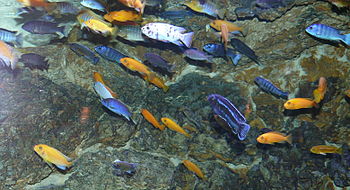A lot of people have been asking me lately about the different cichlid types so I thought I would compile a bit of a thorough list in regards to the various species.
Cichlid (sik-a-lid) fish stem from what's known as the Cichlidae (sik-li-day) family. The Cichlidae family is an extremely large & diverse family having nearly 2000 specimens described and it's believed the still much more to be described scientifically.
 |
| Different Mbuna from Lake Malawi (Photo credit: Wikipedia) |
They would have to be the largest family of vertebrates.
Due to the fact that we are constantly finding new species types, estimating the exact number of cichlid types is very hard to do.
These fish come in some of the strangest looking shapes to the most breathtaking colors and throw in some peculiar mannerisms and it makes for quite the character.
Cichlids are found all across the globe ranging from Africa throughout Asia to North and South America.
Cichlid fish which tend to be kept in captivation can come from the African waters as well as the Amazon basin area and also from some the famous lakes like Lake Malawi, Great African Rift Lake and Lake Tanganyika.
Presently there is a massive diversity in the behavior and eating habits of these fish because of the greater number of types.
The majority of cichlid types are herbivorous fishes and feed on vegetation or even algae. The other cichlid varieties are generally omnivorous, will eat anything or they are carnivorous fishes that live on other fish & insects.
The broad range of eating habits has really allowed cichlid fish to occupy numerous habitats. Cichlid fish do not survive in salt water although funnily enough, their ancestors did.
Most cichlid kinds are fairly scaled down in size and many of them tend to be referred to as game types.
This has lead to several different cichlid species being farmed for human consumption. On the flip side, we can't deny a number of fish tank enthusiasts that enjoy cichlid species because of their eye-catching colorings and tendencies.
Angelfish, Oscar fish, Discus fish and Convict cichlid are among the most popular with aquarium enthusiasts.
African Cichlid Species
Most of the Cichlid types that we see in captivity today come from the African Amazonian regions. So on with the listings!
Lake Malawi
Lake Malawi is one of the largest lakes known to man and is home to over 300 varieties of cichlid fish. Some of the well-known African species are:
* Big-lipped
* Moori or Blue Dolphin
* Malawi Eye-biter
* Linni or Elephant-nose Cichlid
* Livingstoni
* Polystigma
* Venustus
* Deep-Water Haplo
* Electric Blue Haplo
Mbuna Cichlids
* Red-dorsal Afra, Dogtooth
* Fuelleborn's, Fuelleborni
* Trewavas, Red-finned
* Electric Yellow Mbuna, Lion's Cove Yellow
* Malawi Golden
* Johann's Mbuna
* Parallel-striped Mbuna
* Purple Mbuna
* Aurora
* Bumblebee Mbuna or Hornet
* Elongatus, Slender Mbuna
* Snail Shell Mbuna
* Kennyi
* Eduard's Mbuna
* Zebra Mbuna, Zebra Malawi, Cobalt Blue or Nyasa Blue
Peacock Group
* Baensch's Peacock, Yellow Peacock or Sunshine Peacock
* Red Shoulder Malawi Peacock
* Lake Malawi Butterfly
Lake Tanganyika
* Pearly Compressiceps
* Compressiceps
* Frontosa
* Black-finned Slender
* Striped Clown Goby, Striped Goby, Tanganyika Clown
* Dickfeld's Juli
* Checkerboard Julie
* Golden Julie or Ornate Julie
* Regan's Julie or Striped Julie
* Masked Julie or Black-and-White Julie
* Fairy
* Daffodil Brichardi
* Lemon
* Elongated Lemon
* Ocellated Shell-dweller
* Pearl-lined Lamprologus
* Five-bar
* Otostigma, Tripod
* Blue-eyed Tropheus
* Duboisi
* Blunt-headed
* Poll's Tropheus
* Aulonocara
* Lamprichthys
* Synodontis
* Afromastacembelus
Cavity Brooder s
* Altolamprologus
* Lamprologus
* Julidochromis
* Neolamprologus
Mouth Brooder Group of s
* Cyphotilapia
* Cyprichromis
* Eretmodus
* Tropheus
* Xenotilapia
Other African Species
* African Butterfly
* Zebra Haplochromis
* Two-spotted Jewel
* Blood-red Jewel
* Purple or the Common Krib
* African Blockhead or Lumphead
* Zebra Tilapia
* Clown Tilapia
North American Species
* Firemouth
* Convict
* Pearlscale
* Texas
* Midas
* Large Lipped
* Long Fin
* Friedrichsthali
* Jaguar
* Jack Dempsy
* Salvin's or Tricolor
* Red-spotted
* Black Belt
* Nicaragua
* Quetzal or Red-headed
South American Species
* Oscar fish or Velvet
* Peacock Bass
* Festa's
* Port Acara or Black Acara
* Pike
* Banded
* Festive
Acaras
* Blue Acara
* Green Terror or Rivulatus
* Saddle or Two-spot Acara
* Keyhole
* Flag Acara
* Golden Dwarf
New World Dwarfs
* Agassiz's Dwarf
* Yellow Dwarf
* Cockatoo Dwarf
* Three-Stripe Dwarf
* Ramirez' Dwarf
Angel Species
* Angelfish
* Altum Angelfish
Discus Species
* Brown Discus Fish
* Green Discus
* Royal Blue Discus
* Heckle Discus or Pompadour Fish
* Waroo or Triangle
Eartheater Cichlids Species
* Cupid
* Pearl or Mother-of-Pearl Eartheater
* Red hump Eartheater
* Paraguay Mouthbrooder
* Demon Fish.



